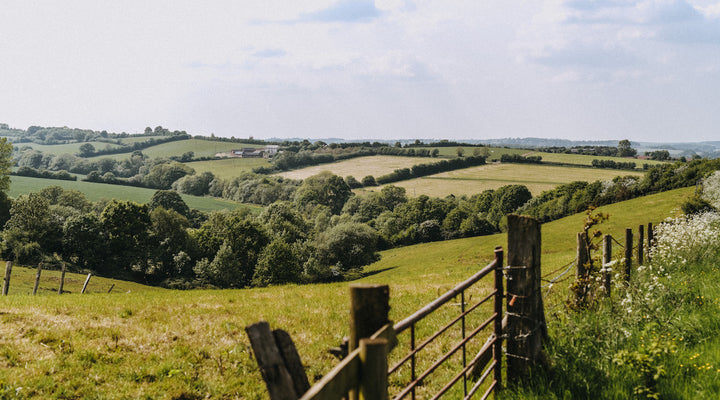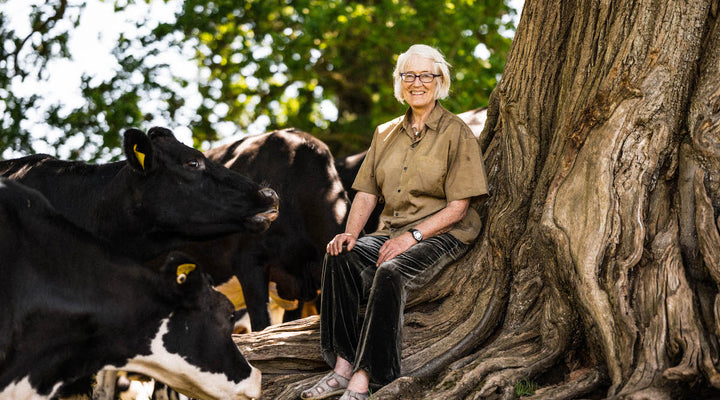Rind is amazing.
It’s what sets us apart from the 99% of cheddar made industrially, put by machine into a plastic bag, which never develops a rind.
The rind is the boundary between cheese and the outside world, and the microflora that grows is a unique expression of our farm.
Historically, cheese once it came out of the mould, would have been dipped in hot water to form the rind, and coated in lard or butter to seal it and slow moisture loss. When cotton became freely available, partly as a result of the British Empire and the cotton mills of Lancashire, cheesemakers started adding a layer of cloth to protect their cheeses.
Compared with cheese made in a bag, which can just sit on a pallet till it is mature, our clothbound cheeses need to be turned every week to ten days, and at 27kgs each, which takes a lot of oomph from our team.
Cheese loses moisture through its rind. That obviously doesn’t happen for industrial cheese that is made in a plastic bag. We expect our large 27kg cheeses to lose up to a couple of kilos between when it is made and when it is mature at around a year. You can think of this as the ‘angel’s share’, a phrase I first heard at a traditional balsamic vinegar producer, who evaporate the vinegar, so there is less to sell, and it is more delicious, hence the very high prices for old balsamic vinegar.
As our cheese ages, particularly after about a year old, the cheese can start to crack and let some of the moulds on the rind into the body of the cheese. A little bit of mould incursion is part of a naturally rinded cheese, and we do cut it out if it’s too much.
For all of this work we put in and loss of weight in the cheese that we can sell, our cheese will be more expensive than industrial cheese.
For it to be worth people paying the extra money that our cheese costs to make, there has to be benefits in what we do to make it worth all that extra cost.
Some Harvard researchers, Ben Wolfe and Rachel Dutton, studied natural cheese rind. What they found was that every clothbound cheese made in the world, in England, Wales, Scotland, America, or Australia will develop the same communities of microflora on their rind. That’s sad, all the cheesemakers thought, we are just the same as everyone else, and why do our cheddars all taste so different? Then the researchers looked more closely and discovered that each farm has its own unique set of subspecies. The cheesemakers were relieved: we could see where the distinctiveness came from in each of our handmade cheeses.
When you walk into our cheese store, you can catch a horseradishy, earthy note, that arises from our precise microflora, that is subtly different from other cheese stores.
A wonderful thing about a naturally rinded cheese is the way the flavours change from the heart of the cheese to the rind. At the heart of the cheese – the centre of the wedge on your cheeseboard - the moisture is higher, the flavour slightly sharper, and it has a more buttery flavour. Halfway back, the cheese is where it has lost less moisture, you get slightly more nutty notes where it is less sharp in flavour. Under the rind, where the cheese has lost most moisture, the flavours aren’t sharp at all, and you get the earthy and horseradishy notes of our microflora : the aroma of our cheese store, unique to us. I find each of those flavours interesting in their own right, with layers of flavour developed by that interaction with the outside world.
That’s why people tell you not to cut off the nose of a wedge of cheese. If you only have a slice of the nose, or halfway back or under the rind, that’s only one flavour each slice. If you take your slice from the nose to the rind, each slice of our cheese contains all three of those flavours, adding to the layers of flavour that our cheese gives anyway.
When we started appreciating what we are dealing with, we decided to swap some of our cheeses with James Montgomery, a Somerset cheesemaker. It was remarkable to see the differences in flavour between our cheese matured there and here and his cheesese mature here and there.
Now, with the Academy of Cheese, we have set up the Affineur of the Year competition. In the first year, we just sent out cheeses from one vat’s make to mature in ten different places, to see what happened, and they were different enough for people to play again. This year, we have sent out our cheeses and 2 other cheesemakers have joined in: Cropwell Bishop Stilton and Fen Farm Baron Bigod to see what happens. Perhaps we will create completely new flavours! We will all be tasting the results at the final judging, in London on Wednesday 14th of June.
Mary Quicke








